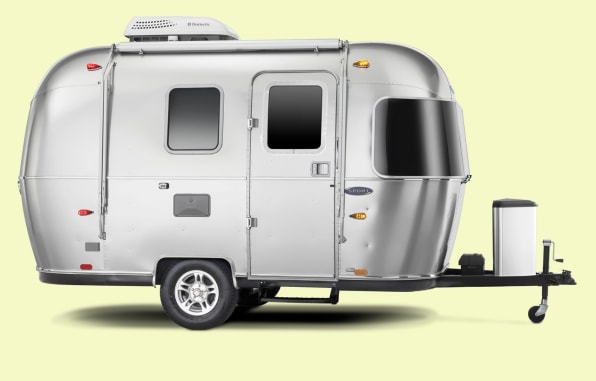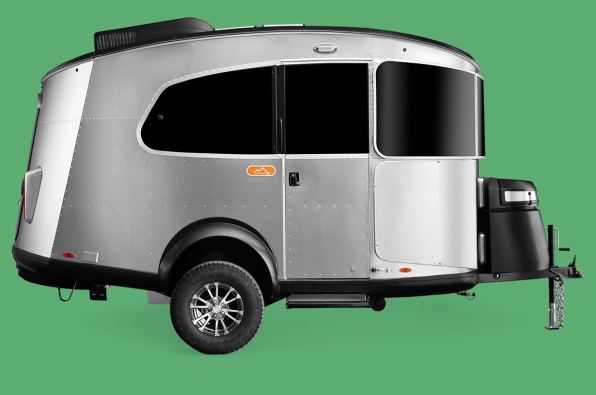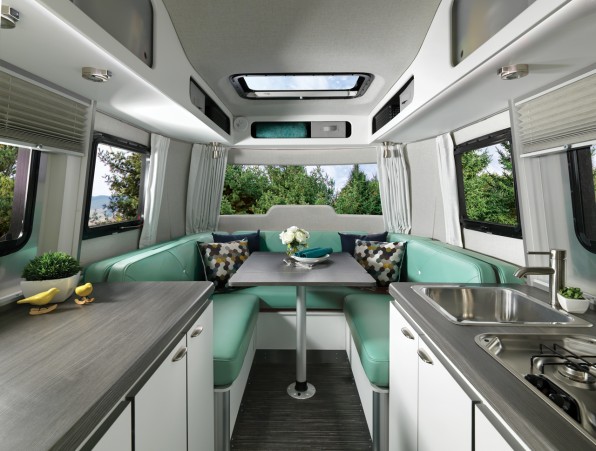The trailer company is riding a five-year high aided by younger customers and new design. But Airstream’s future will be a lot more complicated.
In the age of iPhones, Slack notifications, and burritos delivered to our door, we all long for adventure. Call it unplugging, or #vanlife. But as it turns out, escaping the grind of the 9 to 5 is big business unto itself.
For the past five years, Airstream–yes, the 86-year-old company that makes those gleaming aluminum trailers–has celebrated a new golden age of growth. With sales up 218% over that time, the company has been operating at full production capacity, building 110 trailers a week for months; it’s now expanding to a 750,000-square-foot production facility in its home town of Jackson Center, Ohio, which will open in 2019. Already a hit with millennials who want to work on the road, the company is releasing two smaller, lower-cost models to continue wooing these younger customers, and looking to partner with designers and companies that can help it evolve.
But over an hour-long conversation with Airstream CEO Bob Wheeler, I was most surprised by this irony: that while Airstream is built upon disconnecting from the digital world, Wheeler sees Airstream’s future in designing to accommodate it.

HISTORY REPEATS ITSELF
It’s easy to see echoes of today in Airstream’s origin story. Founder Wally Byam was a young go-getter who not only got accepted to Stanford in 1921, but paid his own way by working side hustles, selling concessions at sporting events, and sailing during the summer. Eight years later, satiating a love for travel, he modified a Model T with a camping tent. The tent leaked, and his wife hated it. So he built a full metal trailer and started selling them. The trailer business barely weathered the storm of the Great Depression, but the industry would really take off after World War II, when metal rationing was down, troops came back to war to start families, and those families needed affordable vacations to our national parks in the 1950s and ’60s.
The modern era for the company began in 2008, when Wheeler–who had been an Airstream product designer and engineer for six years–took over as CEO. The company was coming off a time of decent organic growth that was largely the result of infrastructural improvements, like getting dealers and distributors on the ground in more areas and modernizing the Airstream cabin’s interiors. But Wheeler “had the pleasure,” as he puts it, of taking control during the subprime mortgage lending crisis and subsequent recession.
“Our business was down 60% in ’08 and ’09 fiscal years. But coming out of that, there were a lot of things [in our favor],” says Wheeler. “There was a cultural shift away from conspicuous consumption. We were small and luxurious. People didn’t want small and cheap.”
Two years after Wheeler took over, Instagram was founded. It became the perfect platform to advertise travel and adventure to a whole new generation of potential Airstream buyers. Nothing punctuated a scenic vista or campsite like an aluminum trailer that looked straight out of a simpler time.
“We’re instantly recognizable,” Wheeler laughs, pointing out that Airstream is a natural match for social media–unlike companies that sell, say, toilets. Airstream’s own research on millennials mirrors what’s now common knowledge: that these younger consumers measure their self-worth by the adventures they’ve had, rather than the things that they own. “We rarely talk about the product itself; it’s really about the experiences it creates,” says Wheeler.
So beginning in 2010, Airstream embraced its own right-place, right-time luck as a brand with an iconic product that symbolized adventure. For instance, the company began sponsoring travelers with free multi-month Airstream rentals if they blogged about the experience. And it just started a new artist-in-residence program, lending trailers to musicians on tour, demonstrating the Airstream as a creative tool unto itself.
It’s a strategy that aligned with the social and cultural forces that seemed to suggest the 1940s all over again: a new generation of people light on cash wanting to adventure and rediscovering the national parks, which they’re now visiting in record numbers.
Airstream did more than make a few smart or lucky marketing plays, though. The company also began to shift its portfolio to accommodate the millennial buyer.

TEACHING AN OLD BRAND NEW TRICKS
To this day, Airstream’s most popular units are the 16-foot and 22-foot Sport models–which look like the Airstream you probably picture in your head. But in the past year, the company introduced two new trailers that each cost under $50,000, each with its own design language: the Basecamp, which is a more cylindrical Airstream mini with wiring for solar power, and the Nest, which is the brand’s most drastic stylistic departure to date that eschews the classic Airstream’s curves and metallic look for a fiberglass body.
The Nest’s stylistic departure can be traced back to the fact that, while all other Airstreams are designed internally, its shell was designed by Robert Johans, a vehicle designer from outside the company. When Airstream execs saw the design, “We looked at it and said, ‘I don’t know that we can do a lot better than that. It’s already designed, beautifully done,” says Wheeler, who quickly decided to acquire the spec design. “It’s certainly very different from what we’ve brought to market in the past. But if you relax some of your requirements around aluminum and rivets, you can help curate products like the Nest for the market.”

These new models are much cheaper than classic Airstream models, which can cost well over $100,000. They also hitch to smaller cars than the classic Airstreams, giving them a larger potential market. But the new designs also bring in new customers, Wheeler says.
“We had about 90,000 leads people coming to our website when talking about Nest development. Ninety percent of those people didn’t go anywhere else on our website,” he explains. “That was a pretty good indicator to us–these folks might love the idea of Airstream [the legacy brand] but weren’t necessarily drawn to the aluminum body trailer.”
That sort of behavior is almost opposite of how Airstream sees shoppers react to the aluminum Basecamp, which visitors will often check out, only to be upsold on a more classic model. In other words, design departures aren’t just experiments–they’re a crucial part of the brand’s future.
“We recognize if we don’t bring in outside influence [and] open ourselves to partnerships and bring designers to the table that think differently about the brand that we do, we’ll become an irrelevant, isolated, Ohio-built-in-a-cornfield company with a product that will ultimately be the demise of the company,” says Wheeler.

A DISTINCTLY OFFLINE BRAND GOES ONLINE
There is no doubt, even to Wheeler, that Airstream’s most recent comeback ties directly into society’s need to unplug. And by unplug, he doesn’t just mean escape from one’s job into nature. He means to escape the startup economy and e-commerce by embracing the romantic, heritage brands that have been so appealing since the mid-aughts hipster movement.

“Our world full of flawless digital devices creates a vacuum for authentic, maybe slightly clunkier old-school brands that represented . . . something other than [the] mass-produced digital environment we spend so much time on,” he says.Yet, at the same time, Wheeler’s vision for where Airstream is heading involves embracing the digital age. You can see that in new smarthome-style features that come on the highest-end Airstream model, or in a new AT&T partnership–born from a year of negotiations with the telecommunications company–which brings unlimited LTE data to Airstream vehicles for a very tempting $30 a month.
“This is something we’ve been debating inside the company probably for 10 years. ‘What does camping and enjoying the outside have to do with staying connected. Aren’t they at odds?’” asks Wheeler. “Honestly, we’ve come around to this position that we treat connectivity the same way you’d want any other utility when camping. You need water, electricity, gas. We now look at connectivity as another utility folks expect.”
Wheeler points to the results of a new KOA campground study. It found people who had the ability to connect when camping actually camped longer than those who did not. “It enables people to take more trips and stay on those trips longer,” says Wheeler. “We said, look, if this enables people to get out more, who are we to say you can’t have connectivity so you can connect with nature? That’s not our place. Our goal is to get people out as much as we can.”
Wheeler imagines a near future where all this connectivity will make trailer camping safer and more dependable. Sensors could tell the user if a trailer hitch is connected improperly, or message you on a hike if the cabin temperature is getting too hot and you have pets inside. With the press of a button, you might turn on your AC from the top of a mountain.
He also alludes to the potential of Roadtrippers, an app recently acquired by Airstream’s parent company, Thor Industries. Roadtrippers is basically a travel planner built for the fly-over states rather than big cities, leading travelers to recommendations outside of major metropolitan areas. And while Wheeler doesn’t offer a lot of details, he believes Airstream can use an app to extend its brand from trailer company to adventure planner, creating an itinerary that makes sure you won’t get your trailer stuck beneath an overpass or miss that big ball of twine.
When I float the possibility that Airstream could be overreaching, taking on big companies like Google that dominate the mapping market, he simply insists that Roadtrippers “is the anti-Google.”
“Roadtrippers is about light detours, not point A to B,” says Wheeler. “That really aligns well with what we like as a company, what our customers want. They’re traveling for leisure and recreation, not efficiency and speed.”
The rise of self-driving cars is likely the biggest threat on Airstream’s horizon. Wheeler readily agrees that autonomous vehicles will rapidly evolve into recreational rooms on wheels that, ultimately, look a whole lot like what Airstream has been building for nearly a century. In a few years, Airstream could have a lot more competitors than it does today–and simply put, who will tow a trailer in a future when the car is the trailer? However, Wheeler hopes Airstream’s history is a competitive advantage, rather than a path to brand obsolescence.
“We’ve said we can’t design the tech for a car to drive safely, but we’re good at designing blended residential-automotive spaces,” he says. “We know we can play a great role in that, it’s a matter of finding the right partner.”
That’s really the story of Airstream today: Yes, it’s an old Ohio trailer company. But it’s also a digitally literate brand that may manage to leverage its Instagram chops and eye for good design into worldwide domination–or American campground domination, at the very least.








